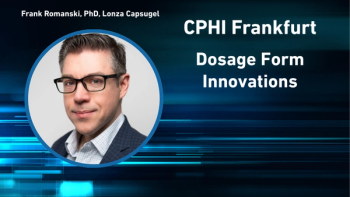
- Pharmaceutical Technology-03-02-2010
- Volume 34
- Issue 3
Spherical Crystallization for Lean Solid-Dose Manufacturing (Part 1)
In Part I of this article, the authors describe the materials and methods used in developing a screening strategy to accelerate the preparation and characterization of spherical agglomerates by spherical crystallization.
Pharmaceutical manufacturing typically lags behind other industries in process efficiencies because production processes for new drug products are quickly developed in a laboratory for producing clinical-trial materials to enable the rapid submission of a new drug application (NDA) (1). The NDA locks in the documented manufacturing steps with a regulatory commitment and leaves no chance for the full optimization of processing steps such as crystallization, filtration, drying, dry blending, granulation, drying, and tableting (2). Granulation is the slowest of these processing steps, but by applying cross-performance relationships and mixing rules, the efficiency of granulation can be enhanced significantly (2–4). To achieve lean solid-dose manufacturing, the granulation step can be replaced with spherical crystallization in a common stirred tank at the crystallization step (5–26). This change may reduce the time-consuming and labor-intensive steps in solid-dose manufacturing for a high-dose formulation to only a few unit operations of spherical crystallization, filtration, drying, dry blending, and tableting.
To the best of our knowledge, no literature has laid out a systematic way to identify the best solvent combinations for spherical crystallization. This article presents a robust miniaturized screening strategy to accelerate the preparation and characterization of spherical agglomerates produced by spherical crystallization. This strategy can be readily adopted or automated using only a small amount of active pharmaceutical ingredient (API), thus enabling spherical crystallization to be performed before the NDA submission.
Spherical crystallization
Spherical crystallization is a well-studied, solvent-based method that directly produces spherically agglomerated crystals to afford free flowability, uniform packability, and good compressibility for mixing, filling, direct tableting, and even burning characteristics (17–19). Spherical crystallization is categorized into two methods: emulsion solvent diffusion (ESD) and spherical agglomeration (SA) (13, 22, 24, 26). Both methods use a good solvent (i.e., a solvent that gave solubility of ≥ 5 mg/mL at 25 °C ) to dissolve the API and a bad solvent (i.e., a solvent that gave solubility of < 5 mg/mL at 25 °C) miscible with the good solvent (i.e., the antisolvent) to generate the required supersaturation. For the ESD method, the solution containing the dissolved API is dispersed into the bad solvent to produce emulsion droplets. Crystals are generated inside the suspended droplets by the counterdiffusion of the good and bad solvents at the droplet interface (26). However, for the SA method, the formation of agglomerates is promoted by the addition of a small amount of the third solvent, namely the bridging liquid, which is immiscible with the bad solvent and drawn preferentially in the interstitial space between the newly formed API crystals (26).
Spherical crystallization is a very versatile method. The operating conditions involve either: the recrystallization of a near-saturated solution by cooling (10, 12, 13, 15, 16, 19, 21, 22, 25, 26), by seeding (14), or by an antisolvent (7, 8, 10–13, 15, 16, 19–26) with (7, 8, 10–13, 15, 20–26) or without (19, 22) the presence of a bridging liquid or with the addition of an emulsifying agent (13, 15, 18) or a cross-linking agent (16, 23); or secondly, the dispersion of solids with the addition of a bridging solution (5, 6, 11, 17). The addition order of the antisolvent and the bridging liquid to the near-saturated solution can vary (11, 26).
Spherical crystallization relies on the form space (or the solvent-miscibility plot) derived from an initial solvent-screening method performed in 20-mL scintillation vials (27–31). Because the composition ratio of an antisolvent to a good solvent at the time of nucleation determines the polymorphism of the API crystals, the solvents were added by a specific SA pathway (11, 12, 30). The antisolvent was first added to the near-saturated API solution to ensure the occurrence of recrystallization in a binary solvent system. The bridging liquid was introduced at the end point of recrystallization to induce the agglomeration of the existing primary crystals. The polymorphism of the primary crystals before and after spherical agglomeration was monitored by either differential scanning calorimetry (DSC) or transmission Fourier transform infrared (FTIR) spectroscopy. The volume of a bridging liquid used, the percent yield, the length-mean diameter, the apparent density, the population density, the sphericity, the angle of repose, and the friability index of spherical agglomerates were carefully measured and calculated (5, 9, 13, 23). The internal microstructures of spherical agglomerates were examined by scanning electron microscopy (SEM).
The feasibility of spherical crystallization by initial solvent screening was tested with three model APIs (32–42) (see Figure 1). These APIs were: carbamazepine (5H-dibenze (b, f) azepine-5-carboxamide), an anticonvulsant used to treat epilepsy and trigeminal neuralgia; cimetidine (N"-cyano-N-methyl-N'-[2-[[5-methyl-1H-imidazol-4-yl]methyl]thio]ethyl)guanidine), a specific competitive histamine H2-receptor antagonist used to treat human peptic ulcers; and phenylbutazone (1,2-diphenyl-4-n-butyl-3,5-pyrazolidinedione), a nonsteroidal antiinflammatory drug with antipyretic and analgesic activity. These APIs were chosen because of several key properties: their nonionizable nature between pH of 6 and 7; their worldwide commercial value; the abundance of characterization information in the literature; the lack of extensive solvent studies on their solubility, polymorphism, crystallinity, and crystal habits; and the variety of their naturally occurring polymorphs, hydrates, and/or solvates.
Figure 1: Molecular structures of (a) carbamazepine,(b) cimetidine, and (c) phenylbutazone. (FIGURE I IS COURTESY OF THE AUTHORS.)
Materials and methods
APIs. Carbamazepine (C15H12N2O), white, crystalline, and prismatic powders, molecular weight (mw) of 236.67 g/mol, melting point (mp) of 191–192 °C, reagent grade, Lot 036k1219, and cimetidine (C10H16N6S), white crystalline rod-like powders, mw of 252.34 g/mol, mp of 141–143 °C, reagent grade, Lot 088H1317 were purchased from Sigma-Aldrich (St. Louis, MO) and used as received. Phenylbutazone (C19H20N2O2), white, crystalline, and needle-shaped powders, mw of 308.38 g/mol, mp of 106–108 °C, purity of 99+ %, Lot A0230775 was purchased from Acros Organics (Morris Plains, NJ) and used as received. Identification tests for carbamazepine and phenylbutazone were carried out by DSC. The use test for cimetidine was performed by FTIR instead of DSC because DSC was unable to distinguish the polymorphs of cimetidine clearly (39).
Solvents.The following sovlents were obtained from Tedia (Fairfield, OH): acetone (CH3COCH3), high-performance liquid chromatographical/spectrometrical (HPLC/spectro) grade with purity of 99.5%, boiling point (bp) of 56 °C, mw of 58.08 g/mole, Lot 411050; n-butyl alcohol (CH3 (CH2)3OH), American Chemical Society (ACS) grade with purity of 99.4%, bp of 117.7 °C, mw of 74.12 g/mole, Lot 205027; N,N-dimethylformamide (HCON(CH3)2), ACS grade with purity of 99.8%, bp of 153 °C, mw of 73.10 g/mole, Lot 020505; n-heptane (CH3 (CH2)5CH3), HPLC/spectro grade with purity of 99.4%, bp of 98 °C, mw of 100.21 g/mole, Lot HS-1712 ; isopropyl alcohol ((CH3)2CHOH), HPLC/spectro grade with purity of 99.8%, bp of 82.4 °C, mw of 60.1 g/mole, Lot 503027; methanol (CH3OH), HPLC/spectro grade with purity of 99.9%, bp of 64.7 °C, mw of 32.04 g/mole, Lot 411070; methyl ethyl ketone (C2H5COCH3), ACS grade with purity of 99.6%, bp of 81.6 °C, mw of 72.11 g/mole, Lot 201021; methyl tert-butyl ether ((CH3)3COCH3), certified grade with purity of 99.9%, bp of 55.2 °C, mw of 88.15 g/mole, Lot 712032; tetrahydrofuran (C4H8O), HPLC/spectro grade with purity of 99%, bp of 65–67 °C, mw of 72.11 g/mole, Lot 411013; and xylene (C6H4 (CH3)2), ACS grade with purity of 98.5%, bp of 137–144 °C, mw of 106.17 g/mole, Lot 305065.
The following solvents were obtained from Acros Organics: N,N-dimethylaniline (C6H5N(CH3)2), ACS grade with purity of 99%, bp of 193 °C, mw of 121.18 g/mole, Lot A0213203001 and p-xylene (C6H4 (CH3)2), ACS grade with purity of 99%, bp of 138 °C , mw of 106.17 g/mole, Lot 48754/2. 1,4-Dioxane (C4H8O2), ACS grade with purity of 98%, bp of 100–102 °C, mw of 88.11 g/mole, Lot sp-3432R was obtained from Showa Chemical (Tokyo). Chloroform (CHCl3), HPLC/spectro grade with purity of 99.9%, bp of 60.5–61.5 °C, mw of 119.38 g/mole, Lot E554180 and ethanol (CH3CH2OH), HPLC/spectro grade with purity of 99.5%, bp of 78 °C, mw of 46.7 g/mole were obtained from Echo Chemical (Taipei, Taiwan). Ethyl acetate (CH3COOC2H5), ACS grade with purity of 99.5%, bp of 76.5–77.5 °C, mw of 88.11 g/mole, Lot G43342 was obtained from Grand Chemical (Daejeon, South Korea). Acetonitrile (CH3CN), ACS grade with purity of 99.96%, bp of 81.6 °C, mw of 41.05 g/mole, Lot 0043X29B30, and toluene (C6H5CH3), HPLC/spectro grade with purity of 99.8%, bp of 110.6 °C, mw of 92.14 g/mole, Lot B46755 was purchased from Mallinckrodt Baker (Phillipsburg, NJ). Reversible-osmosis (RO) water was clarified by a water purification system (Milli-RO Plus, Millipore, Billerica, MA).
Initial solvent screening. Under the initial solvent screening, the 19 solvents specified in the solvents section were chosen. The working procedures followed closely the details described in References 27–30. As previously defined, a good solvent was a solvent that gave solubility of ≥ 5 mg/mL at 25 °C. A bad solvent, or antisolvent, was a solvent that gave solubility of < 5 mg/mL at 25 °C). The form space was constructed in a framework of 19 X 19 solvent matrix (27–30).
Solvent-miscibility studies. The working logics followed the procedures laid out in References 27–30.
Spherical agglomeration. Good solvents, antisolvents, and bridging liquids were chosen according to the form space of each API. For carbamazepine and phenylbutazone, approximately 30 mg of API were dissolved in 2 mL of a good solvent in a 20-mL scintillation vial. For cimetidine, 2 mL of saturated solution were prepared using a good solvent. Then, 10 mL of an antisolvent were added to all API solutions under a standardized agitation of 200 rpm by an orbital shaker (Model OS-701, TDK , Taipei). The 5:1 volume ratio of the antisolvent to the good solvent was based on a specified cystallization method (11). Crystallization only took place in some of the solution systems.
Two hours after the first appearance of solids, the solids were filtered, oven-dried under a mild condition at 40 °C overnight, and characterized for their purity, polymorphism, solvates, and crystallinity by DSC, thermal gravimetric analysis (TGA), and FTIR.
Next, 0.02-mL portions of a bridging liquid were added in the remaining slurry every once in a while by a micropipette until all suspended crystals were transformed into agglomerates by sight. The amount of the bridging liquid used should be kept at minimum without causing any dissolution of the primary crystals or exceeding 80% volume (i.e., 16 mL in total solution volume) of the scintillation vial. All trials were performed at room temperature, and all agglomerates were filtered, oven-dried under mild conditions of 40 °C overnight, and characterized. For carbamazepine spherical agglomerates, oven-drying at 100 °C for 4 h was performed before any further characterization. For the solution systems that gave rise to spherical agglomerates, experiments were repeated again without the addition of any bridging liquid to produce primary crystals that were filtered, oven-dried at 40 °C overnight, and characterized for their polymorphism by either DSC or FTIR.
DSC. Thermal analytical data of 3 to 5 mg of solids placed in perforated-aluminum-sealed 60-µL pans were collected on a calorimeter (Perkin Elmer DSC-7, Perkin Elmer, Waltham, MA), with the following temperature scanning rates: 10 °C/min from 50 to 200 °C for carbamazepine; 5 °C /min from 50 to 170 °C for cimetidine (mainly for the crystallinity measurements); and 8 °C/min from 50 to 130 °C for phenylbutazone using nitrogen with purity of 99.990 % as a blanket gas (32, 33, 35, 39, 41). The temperature axis was calibrated with indium with purity of 99.999% (Perkin Elmer) with a melting onset at 156.6 °C.
TGA. Sample-weight loss as a function of temperature was monitored by a thermogravimetric analyzer (TGA 7, Perkin Elmer). The heating rate was 10 °C/min from 50 to 200 °C, 5 °C/min from 50 to 170 °C and 8 °C/min from 50 to 130 °C for carbamazepine, cimetidine, and phenylbutazone, respectively (32, 33, 39, 41). Weight loss was usually associated with either solvent evaporation close to the boiling point of a solvent, as in the case of solvates, or sample decomposition. The open platinum pan and stirrup were rinsed by ethanol and burned by a spirit lamp to remove all impurities. All samples were heated under nitrogen atmosphere to avoid oxidization. About 3 mg of sample were placed on the open platinum pan suspending in a heating furnace.
FTIR spectroscopy. Transmission FTIR spectra were recorded on a spectrometer (Perkin Elmer Spectrum One, Perkin Elmer) Approximately 1 mg of sample was ground gently with 99 mg of 50 °C oven-dried potassium bromide (KBr) in an agate mortar and pestle to avoid polymorphic transition possibly induced by extended grinding. The round KBr sample disk was prepared by a uniaxial press with a pressure of 7 tons. The disk was scanned with a scan number of 8 from 450 to 4000 cm-1 with resolution of 2 cm-1..
Digital camera. A digital still camera (DSC-T7 Cyber-shot, Sony, Tokyo) was used to take photographs of millimeter-sized spherical agglomerates before and after the friability test. The number of spherical agglomerates and their individual diameters were measured based on the image analysis.
Angle of repose. Because of the small amount of spherical agglomerates produced, the angle of repose was measured with the oven-dried spherical agglomerates inside the 20-mL scintillation vial. The vial was mounted on a lever that had one end pivoted to the benchtop and was originally laid flat on the benchtop surface. The vial was tilted by raising the other end of the lever gradually. The angle made between the lever and the benchtop surface at which the spherical agglomerates inside the vial began to flow was the angle of repose. Each angle measurement was repeated at least 10 times with a protractor.
Friability. Spherical agglomerates harvested from each trial were placed in a 20-mL scintillation vial that was subjected to a rotating speed of 50 rpm on a ball-milling machine (MUBM-236-RTD, Shin Kwan Machinery, Taipei) for 30 min. Photographs of spherical agglomerates before and after this friability test were taken. Image analysis was performed to calculate the friability index.
SEM. An SEM (Hitachi S-3500N, Hitachi Ltd., Tokyo) was used to observe the internal morphology of spherical agglomerates that were cross-sectioned by a razor blade. Because the cutting was done by hand, it might have crushed the agglomerates. To avoid imaging the artifacts, the cross-sectioned area was blown with compressed air to remove surface debris. Both secondary electron imaging and backscattered electron imaging were used for the SEM detector, and the magnification was 15- to 300,000-fold. The operating pressure was 10-5 Pa vacuum, and the voltage was 15.0 kV. All samples were mounted on a carbon conductive tape (Prod. No. 16073, TED Pella, Redding, CA) and sputter-coated with gold (Hitachi E-1010 Ion Spotter) with a thickness of about 6 nm. The discharge current used was about 0 to 30 mA, and the vacuum was around 10 Pa.
Tu Lee* is an associate professor, and Yan Chan Su and Hung Ju Hou were graduate students in the Department of Chemical and Materials Engineering, and Hsiang Yu Hsieh was a graduate student at the Institute of Materials Science and Engineering, all at National Central University, 300 Jhong-Da Rd., Jhong-Li City 320, Taiwan, ROC, tel. +886 3 422 7151 ext. 34204, fax +886 3 425 2296,
*To whom all correspondence should be addressed.
Submitted: Feb. 2, 2009; Accepted May 20, 2009.
References
1. P. McKenzie et al., AIChE J. 52 (12), 3990–3994 (2006).
2. N.A. Lewis, Pharm. Technol. 30 (10), 94–108 (2006).
3. T. Lee and F.B. Hsu, Drug Dev. Ind. Pharm. 33 (11), 1273–1284 (2007).
4. T. Lee et al., Drug Dev. Ind. Pharm. 34 (5), 522–535 (2008).
5. Y. Kawashima and C.E. Capes, Powder Technol. 10 (1), 85–92 (1974).
6. Y. Kawashima and C.E. Capes, Powder Technol. 13 (2), 279–288 (1976).
7. Y. Kawashima, M. Okumura, and H. Takenaka, Science 216 (4550), 1127–1128 (1982).
8. Y. Kawashima et al., J. Pharm. Sci. 73 (10) 1407–1409 (1984).
9. Y. Kawashima, M. Okumura, and H. Takenaka, Powder Technol. 39 (1), 41–47 (1984).
10. Y. Kawashima et al., J. Pharm. Sci. 74 (11), 1152–1156 (1985).
11. A. Sano, Chem Pharm. Bull. 37 (8), 2183–2187 (1989).
12. Y. Kawashima et al., J. Pharm. Sci. 80 (5), 472–478 (1991).
13. K. Morishima et al., Powder Technol. 76 (1), 57–64 (1993).
14. Y. Kawashima et al., Powder Technol. 78 (2), 151–157 (1994).
15. K. Morishima et al., Int. J. Pharm. 105 (11), 11–18 (1994).
16. A.M. Garcia and E.S. Ghaly, J. Controlled Release 40 (3), 179–186 (1996).
17. A.H.L. Chow and M.W.M. Leung, Drug Dev. Ind. Pharm. 22 (4), 357–371 (1996).
18. U. Teipel, T. Heintz, and H.H. Krause, Propellants, Explosives, Pyrotechnics 25 (2), 81–85 (2000).
19. P. Szabó-Révész et al., Powder Technol. 114 (1), 118–124 (2001).
20. A.R. Paradkar et al., Drug Dev. Ind. Pharm. 28 (10), 1213–1220 (2002).
21. P. Szabó-Révész et al., J. Crystal Growth 237–239 (Part 3), 2240–2245 (2002).
22. Y. Kawashima et al., Powder Technol. 130 (1), 283–289 (2003).
23. A.P. Pawar et al., AAPS PharmSciTech. 5 (3), Article 44 (2004).
24. S. Bhadra et al., Pharm. Technol. 28 (2), 66–76 (2004).
25. M. Maghsoodi et al., Drug Dev. Ind. Pharm. 33 (11), 1216–1224 (2007).
26. J. Katta and A.C. Rasmuson, Int. J. Pharm. 348 (1–2), 61–69 (2008).
27. T. Lee, C.S. Kuo, and Y.H. Chen, Pharm. Technol. 30 (10), 72–92 (2006).
28. T. Lee, Y. H. Chen and C.W. Zhang, Pharm. Technol. 31 (6), 72–87 (2007).
29. T. Lee and M.S. Lin, Cryst. Growth and Design 7 (9), 1803–1810 (2007).
30. T. Lee et al., Pharm. Technol. 33 (6), 54-61 (2009).
31. J. Alsenz and M. Kansy, Adv. Drug Deliv. Rev. 59 (7), 546–567 (2007).
32. L.E. McMahon et al., J. Pharm. Sci. 85 (10), 1064–1069 (1996).
33. A.L. Grzesiak et al., J. Pharm. Sci. 92 (11), 2260–2271 (2003).
34. N. Rodríguez-Hornedo and D. Murphy, J. Pharm. Sci. 93 (2), 449–460 (2004).
35. F. Tian et al., J. Pharm. Sci. 96 (3), 584–594 (2007).
36. B. Hegedüs and S. Görög, J. Pharm. Biomed. Analysis 3 (4), 303–313 (1985).
37. S. Sudo, K. Sato, and Y. Harano, J. Chem. Eng. Japan 24 (2), 237–242 (1991).
38. A. M. Tudor et al., Spectrochimica Acta, 47A (9–10), 1389–1393 (1991).
39. A. Bauer-Brandl, Intl. J. Pharm. 140 (2), 195–206 (1996).
40. W.A. Bueno and E.G. Sobrinho, Spectrochimica Acta 51A (2), 287–292 (1995).
41. M.D. Tuladhar, J.E. Carless, and M.P. Summers, J. Pharm. Pharmacol. 35 (4), 208–214 (1983).
42. T. Hosokawa et al., Cryst. Eng. Comm. 6 (44), 243–249 (2004).
Note
The results and related discussion will be included in
Note
For a detailed review of approaches in initial solvent screening, see Part I and Part II of the article, "Initial Solvent Screening of Carbamazepine, Cimetidine, and Phenylbutazone," which respectively appeared in the May and April 2009 issues of Pharmaceutical Technology.
Articles in this issue
over 15 years ago
In the Spotlight March 2010over 15 years ago
Time for a Model Upgradeover 15 years ago
Report from Indiaover 15 years ago
Navigating the Global Pharmaceutical Supply Chainover 15 years ago
Industry Pipelineover 15 years ago
Statistically Justifiable Visible Residue Limitsover 15 years ago
Consumers Need Access to Lower-Cost Biogenericsover 15 years ago
Uptick or Sustainable Growth?over 15 years ago
Pharma Capsulesover 15 years ago
Opportunities in the Biosimilars MarketNewsletter
Get the essential updates shaping the future of pharma manufacturing and compliance—subscribe today to Pharmaceutical Technology and never miss a breakthrough.





